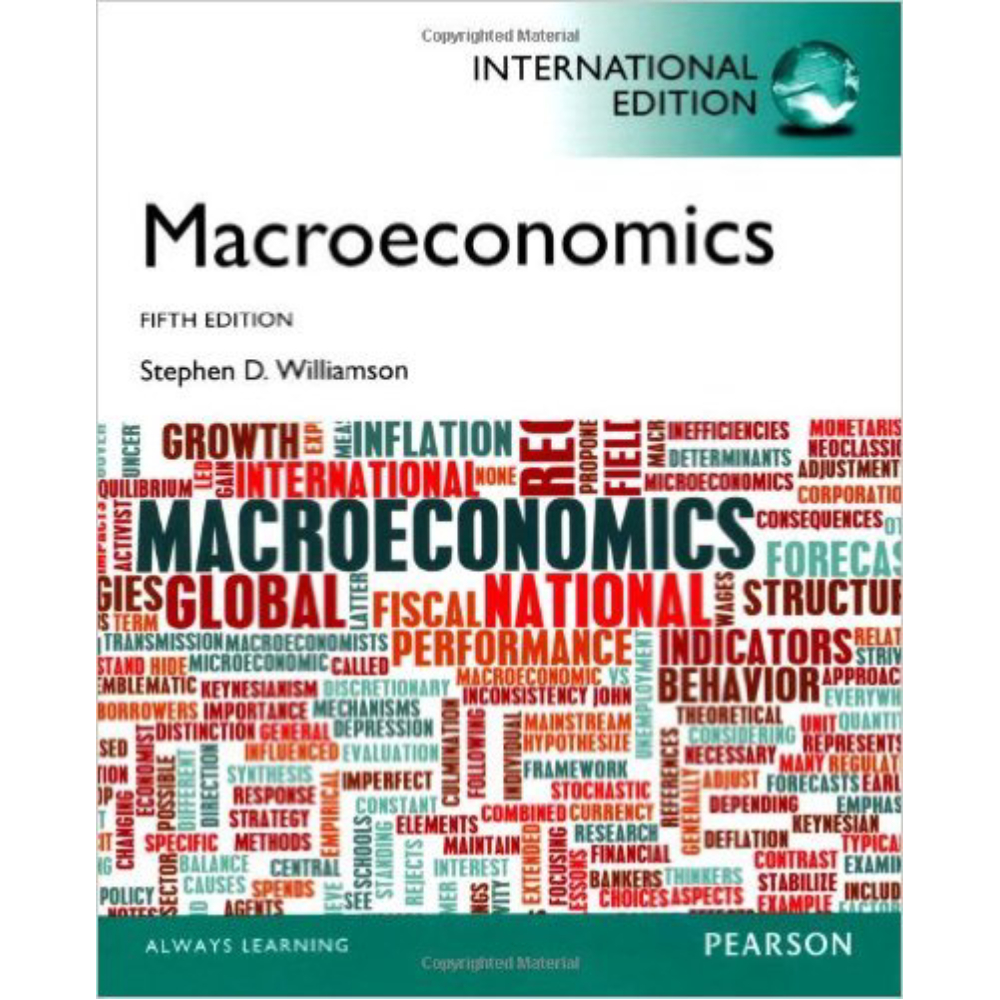Macroeconomics International Edition 5th Edition By Stephen D. Williamson – Test Bank
$55.00
Macroeconomics International Edition 5th Edition By Stephen D. Williamson – Test Bank
You will receive this product within 24 hours after placing the order
Macroeconomics 9th Edition by William Boyes – Test Bank
Chapter 11 Fiscal Policy
MULTIPLE CHOICE
1. The sum of the unemployment rate and the inflation rate is known as:
a. the macroeconomic index.
b. the mortality rate.
c. the market index.
d. the misery index.
e. a coincident indicator.
ANS: D DIF: Easy REF: Introduction OBJ: ch. 11, 1
NAT: Analytic | The Role of Government TOP: Introduction
MSC: Knowledge
2. When the government uses taxes and spending to affect national economy, it is engaging in:
a. fiscal policy.
b. monetary policy.
c. interest rate policy.
d. trade policy.
e. exchange rate policy.
ANS: A DIF: Easy REF: 1 OBJ: ch. 11, 1
NAT: Analytic | The Role of Government
TOP: Fiscal Policy and Aggregate Demand MSC: Knowledge
3. The _____ is the difference between potential real GDP and the equilibrium level of real GDP.
a. employment gap
b. inflationary gap
c. GDP gap
d. fiscal gap
e. monetary gap
ANS: C DIF: Easy REF: 1 OBJ: ch. 11, 1
NAT: Analytic | The Role of Government
TOP: Fiscal Policy and Aggregate Demand MSC: Knowledge
4. Ceteris paribus, if the U.S. federal government reduces fiscal spending which of the following will be observed?
a. The aggregate demand curve will shift to the right.
b. The aggregate expenditure in the economy will decrease.
c. The economy will approach potential GDP.
d. The marginal propensity to consume will increase.
e. The average price level will increase.
ANS: B DIF: Moderate REF: 1.a OBJ: ch. 11, 1
NAT: Analytic | The Role of Government
TOP: Fiscal Policy and Aggregate Demand MSC: Knowledge
5. Which of the following can be categorized under fiscal policy?
a. Increase in money supply
b. Decrease in money supply
c. Increase in federal funds rate
d. Decrease in reserve requirement
e. Increase in tax rates
ANS: E DIF: Easy REF: 2.a OBJ: ch. 11, 1
NAT: Analytic | The Role of Government
TOP: Fiscal Policy and Aggregate Demand MSC: Knowledge
6. If the government wants to close a GDP gap, it should:
a. borrow funds from the public by issuing bonds.
b. lower taxes and raise government spending.
c. lower government spending on social security.
d. raise both direct and indirect tax rates.
e. adopt contractionary fiscal policies to control inflation.
ANS: B DIF: Moderate REF: Ch 11, 1.a OBJ: ch. 11, 1
NAT: Analytic | The Role of Government
TOP: Fiscal Policy and Aggregate Demand MSC: Comprehension
7. If aggregate demand intersects aggregate supply in the horizontal range of the aggregate supply curve, then, other things equal, an increase in government spending will:
a. raise real GDP by the amount indicated by the government spending multiplier and leave the price level unchanged.
b. lower real GDP by an amount equal to the increased spending and reduce inflation.
c. raise the price level and leave real GDP unchanged.
d. raise both real GDP and the price level by a multiple of the initial spending increase.
e. have no effect on real GDP or the price level, because all private investment will be crowded out.
ANS: A DIF: Moderate REF: 1.a OBJ: ch. 11, 1
NAT: Reflective Thinking | The Role of Government
TOP: Fiscal Policy and Aggregate Demand MSC: Analysis
8. Suppose the equilibrium level of income exceeds the full employment level of income and there is high inflation. Hence, the government decides to implement a fiscal policy that will act to reduce national output and prices. This can be accomplished by:
a. increasing government spending such that aggregate expenditures are increased.
b. raising taxes and government spending by the same amount such that aggregate supply is decreased and aggregate demand is increased.
c. decreasing government spending such that aggregate demand is reduced.
d. lowering average tax rates such that aggregate supply is increased.
e. increasing transfer payments such that aggregate expenditures decline.
ANS: C DIF: Challenging REF: 1.a OBJ: ch. 11, 1
NAT: Reflective Thinking | The Role of Government
TOP: Fiscal Policy and Aggregate Demand MSC: Analysis
9. Which of the following statements about taxation is incorrect?
a. A tax cut affects aggregate demand indirectly.
b. A tax cut raises income and expenditures.
c. Cutting taxes by $20 is not the same as increasing government spending by $20.
d. A change in taxes does not affect consumption.
e. An increase in taxes decreases income and expenditures.
ANS: D DIF: Easy REF: 1.a OBJ: ch. 11, 1
NAT: Analytic | The Role of Government
TOP: Fiscal Policy and Aggregate Demand MSC: Knowledge
10. Suppose the Congress enacts a 5 percent decrease in annual military expenditures. Other things equal, this can be associated with:
a. a change in the slope of the aggregate demand curve.
b. a leftward shift of the aggregate demand curve.
c. a rightward shift of the aggregate demand curve.
d. a movement down along the aggregate demand curve.
e. a movement up along the aggregate demand curve.
ANS: B DIF: Moderate REF: 1.a OBJ: ch. 11, 1
NAT: Reflective Thinking | The Role of Government
TOP: Fiscal Policy and Aggregate Demand











Reviews
There are no reviews yet.